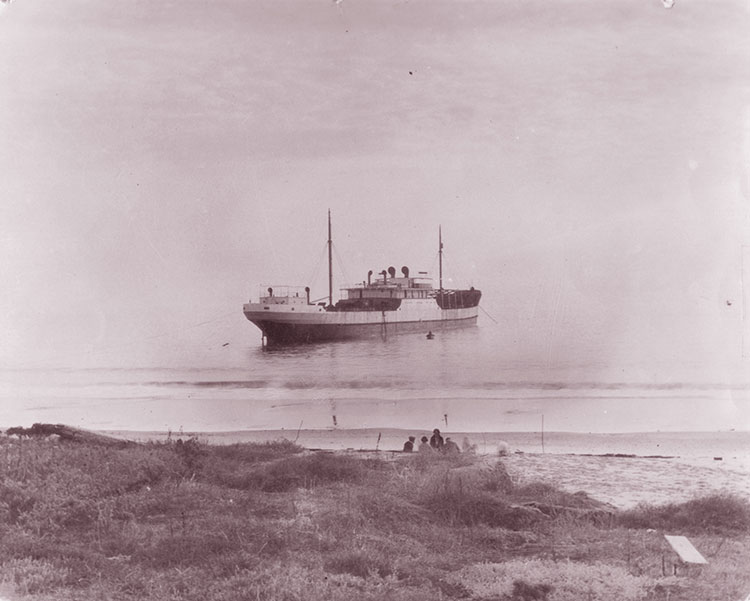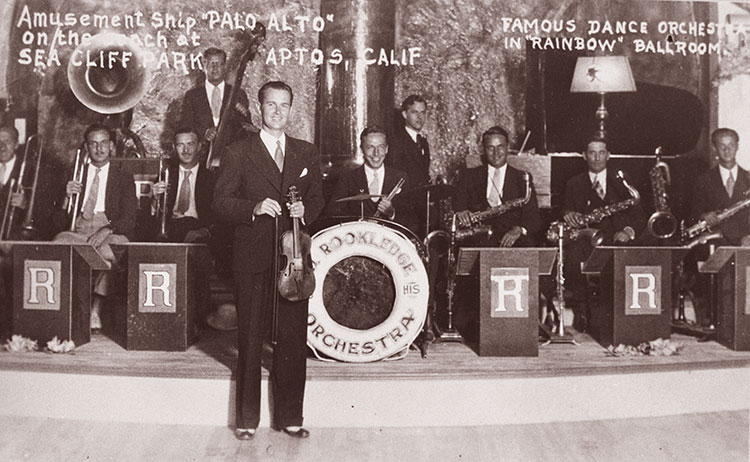Last month, in Part 1 of this story, I told you how the S.S. Palo Alto (The Cement Ship) was originally built as an oil tanker to be used in World War I. However, Armistice was signed about 6 months prior to her completion and as a result, was never used for her intended purpose.
She was launched on May 29, 1919, at the U.S. Naval Shipyard on Government Island. She was left virtually discarded until 1921, when she sailed across San Francisco Bay to Hunter’s Point dry dock. This would be her only voyage under her own power. Then in 1924, she was sold to the Oliver Olson Company who towed her to the Moore Shipbuilding Company in Oakland, where she sat for the better part of 5 years.
Meanwhile, down in Aptos, the Seacliff Amusement Corporation was formed with the intention of building a resort on Seacliff Beach. The main industry in Aptos had gone from ranching, to logging, to apples, and the Seacliff Amusement Corporation was correct with their prediction that the next big industry move would be tourism, but unfortunately their timing was all wrong. This was 1929 and the country was about to enter a time of financial collapse with the Great Depression.
Part of the development plans, which the Santa Cruz Sentinel described as, “a most unique amusement enterprise,” included the 430 foot Cement Ship moored on the Seacliff Beach. Upon this ship would be various forms of entertainment including dining, dancing, swimming, fishing, and whatever else the law would allow … and as it turned out, even a few things the law didn’t allow!
The Seacliff Amusement Corporation purchased the Palo Alto for an undisclosed amount of money and on January 21, 1930, the voyage to her final resting place would begin. She was towed by a Red Stack tug whose orders were to keep her speed under five knots. They left the Moore Shipbuilding Yard in Oakland at 4:00pm and arrived at Seacliff the next morning at 7:00am.
The pier was still in the early stages of construction and it took two days before the ship was in line and able to drop her three 3.5 ton anchors. There was a steel cable that was drawn from the stern of the ship through a block on one of the pier pilings that was operated by a gas-powered winch that pulled the Palo Alto in toward the beach.
On January 25, she was finally in place. The seacocks in the boiler room were opened, allowing the seawater to rush in. Everything below sea level was intentionally flooded allowing her to settle to the bottom of the ocean. It should be noted that she was positioned with the bow (front of the ship) furthest away from land. As David Heron so aptly titled his book about the S.S. Palo Alto, she is “Forever Facing South.”
The Seacliff Amusement Corporation borrowed $28,000 to build out the rest of the pier, dig a 190-foot well for fresh water, and pave the access road down from the Watsonville-Santa Cruz Road (today’s Soquel Drive) and along the beach.
The pier, measuring 630 feet long and 40 feet wide, was finished in early June 1930. On June 21, the ship’s dancehall, The Rainbow Ballroom, was opened up for a special preview event. The dancehall occupied most of the main deck and was 54-feet wide, with tall windows looking out over the Bay. Several hundred people showed up that night and danced the night away with Ed Rookledge’s 10-Piece Orchestra providing the music.
The official opening was the following Saturday night. The music of Ed Rookledge once again filled the Rainbow Ballroom. There were games being played in the amusement arcade, the Ship Café and Fish Restaurant served dinner, and the swimming pool, fishing deck, and promenade were all open. The ship was ablaze with lights, pennants flying from the 76-foot masts, and cars lined the beachfront road and pier.
The Santa Cruz Sentinel reported that 2,000 cars visited Seacliff Beach that weekend and an estimated 3,000 people boarded the Palo Alto! It was indeed a very successful start and it appeared the Palo Alto had finally found her purpose. Sadly, just 2 years later, the Seacliff Amusement Corporation would be bankrupt and the ship’s doors would be closed for good. The dream of a resort in Seacliff was dead.
What happens next will be told in Part 3, the final part of this story.
The Aptos History Museum has teamed up with State Parks and other community volunteers to plan a very special series of events to celebrate this occasion, including a history presentation at the Rio Sands Hotel on May 18th, a musical performance on May 19th at Cabrillo, and a party on June 1st at the Seacliff Visitor Center. More details to come!
•••
For more information about the Aptos History Museum, upcoming events, or becoming a member of the museum, please visit www.aptoshistory.org and follow us on Facebook and Instagram @aptos_history_museum.





